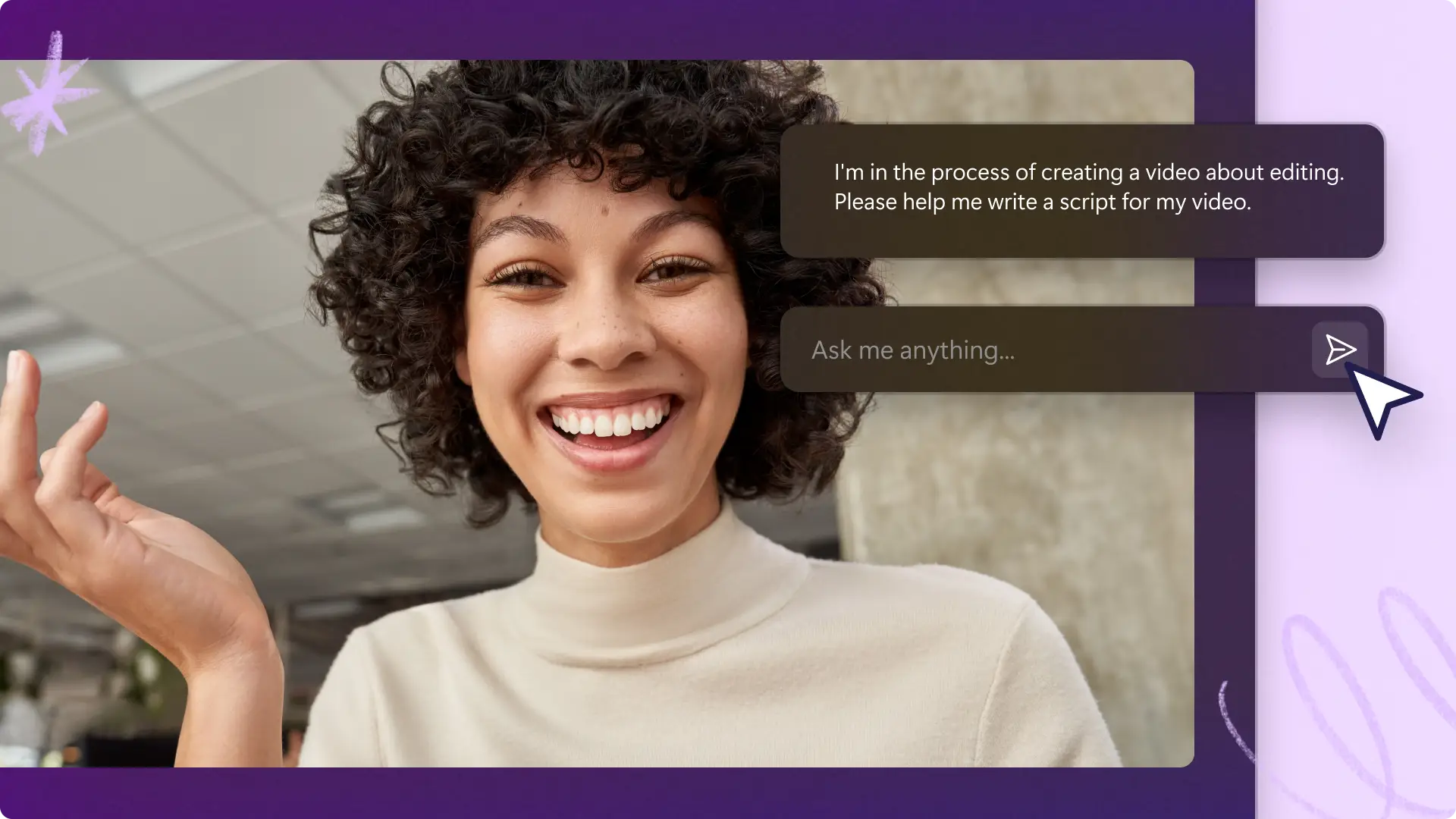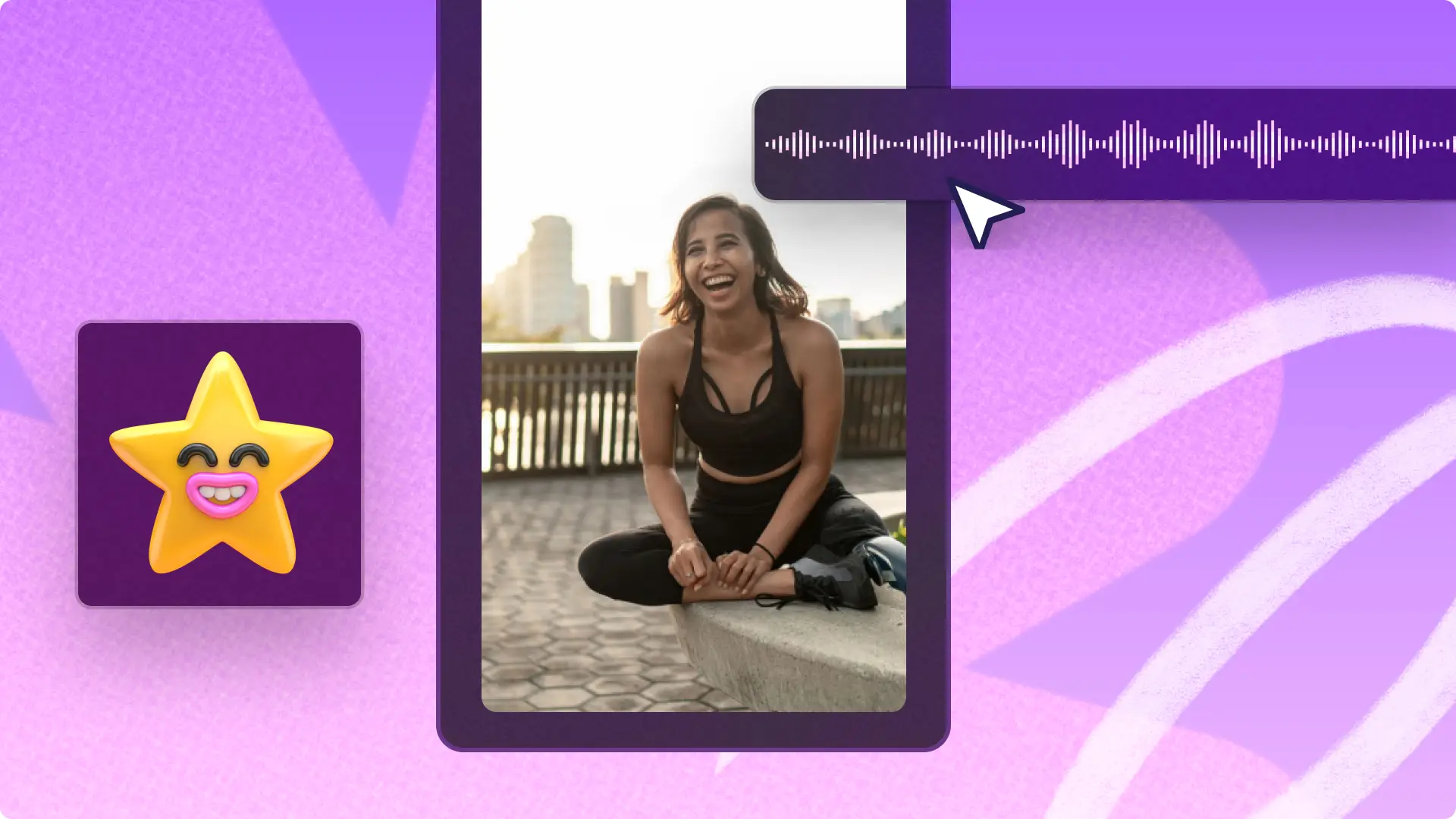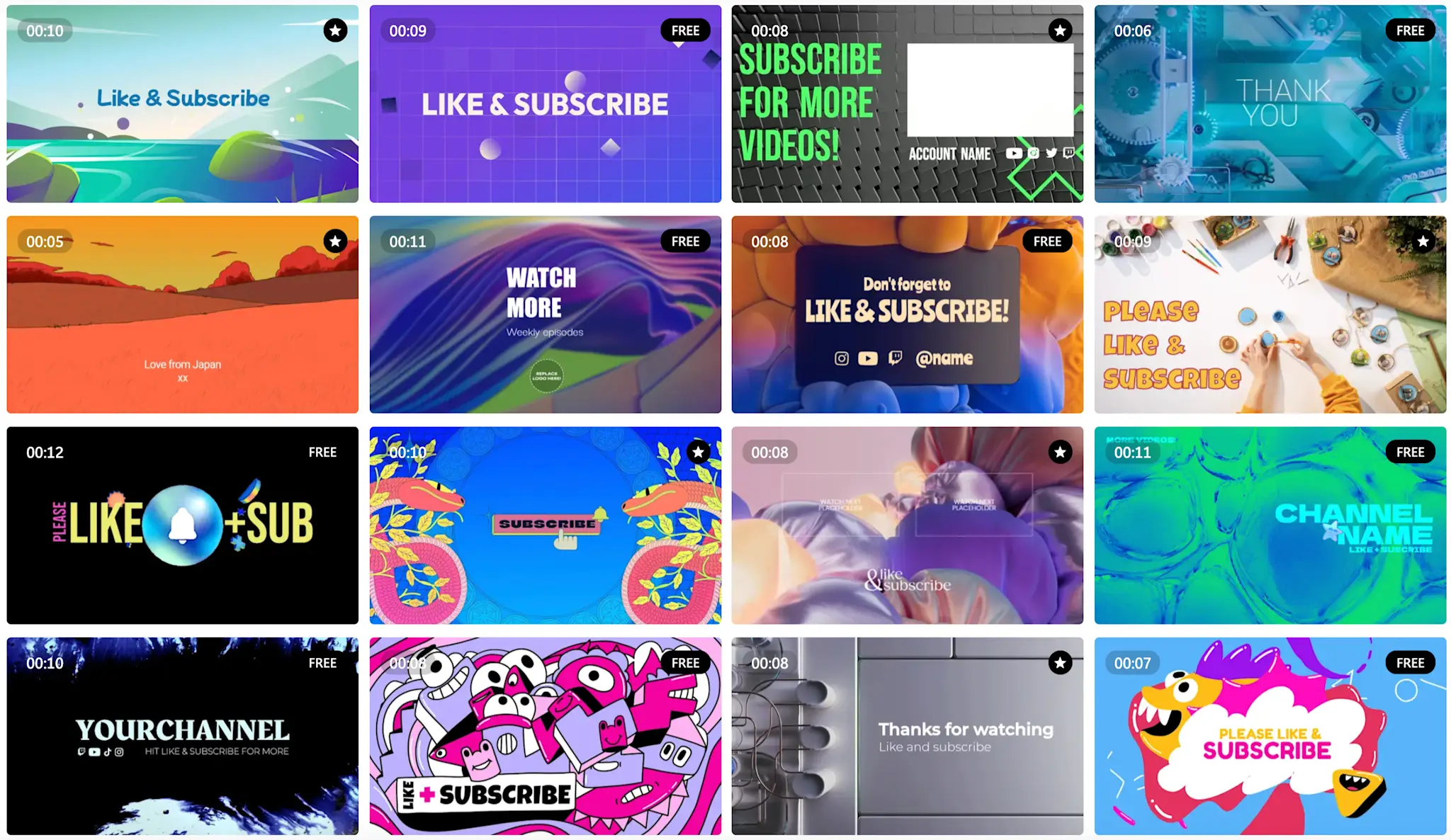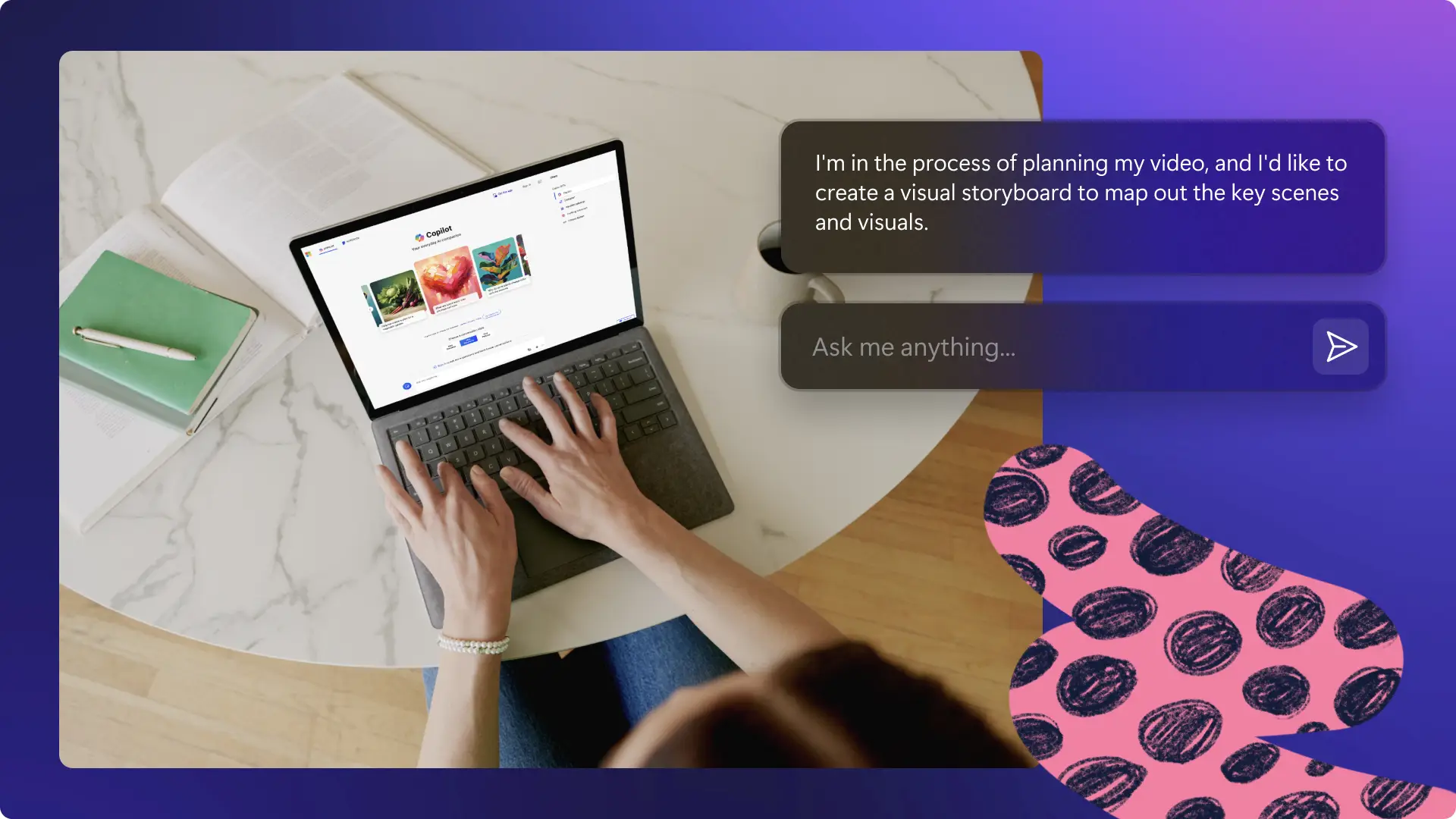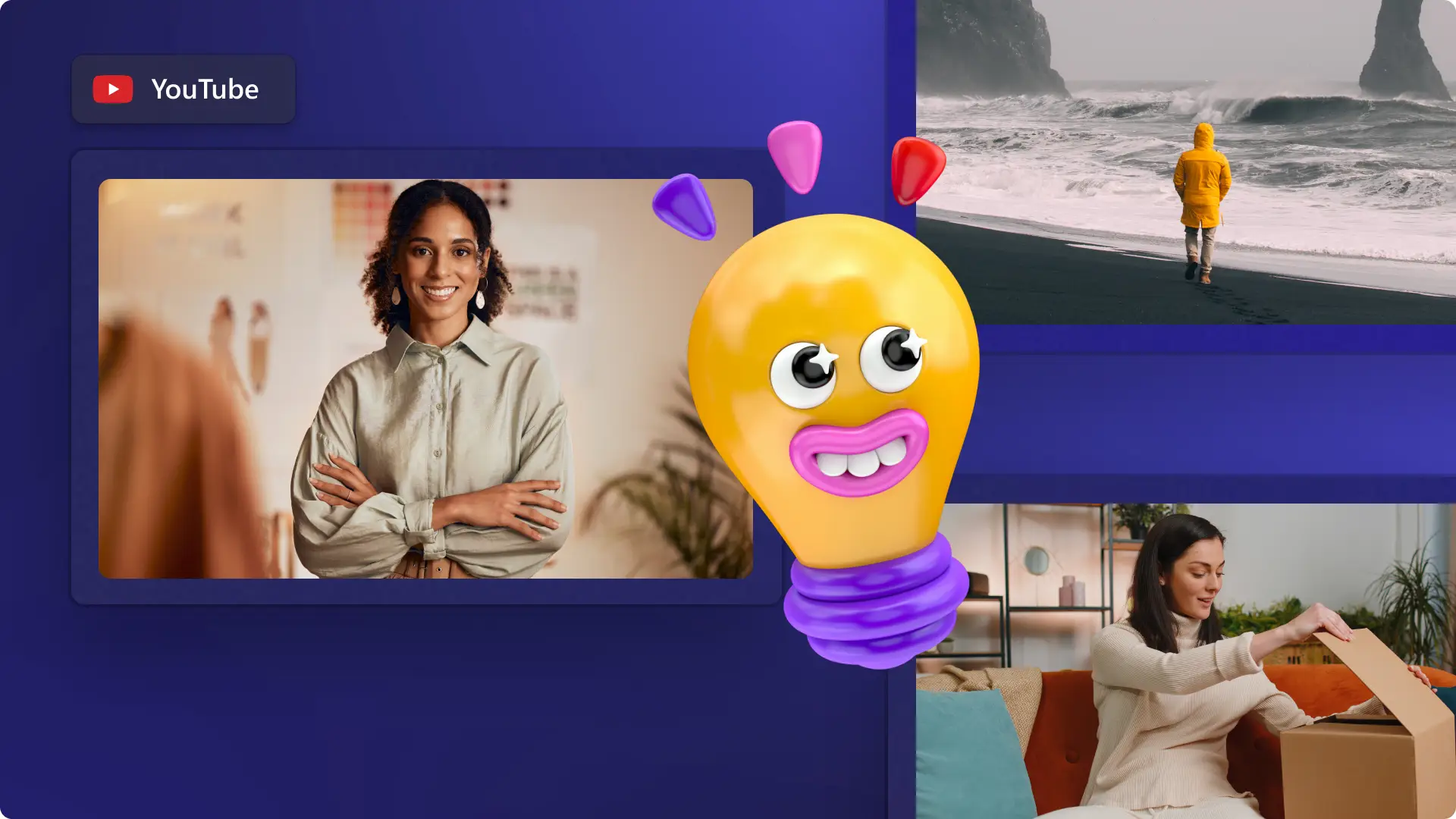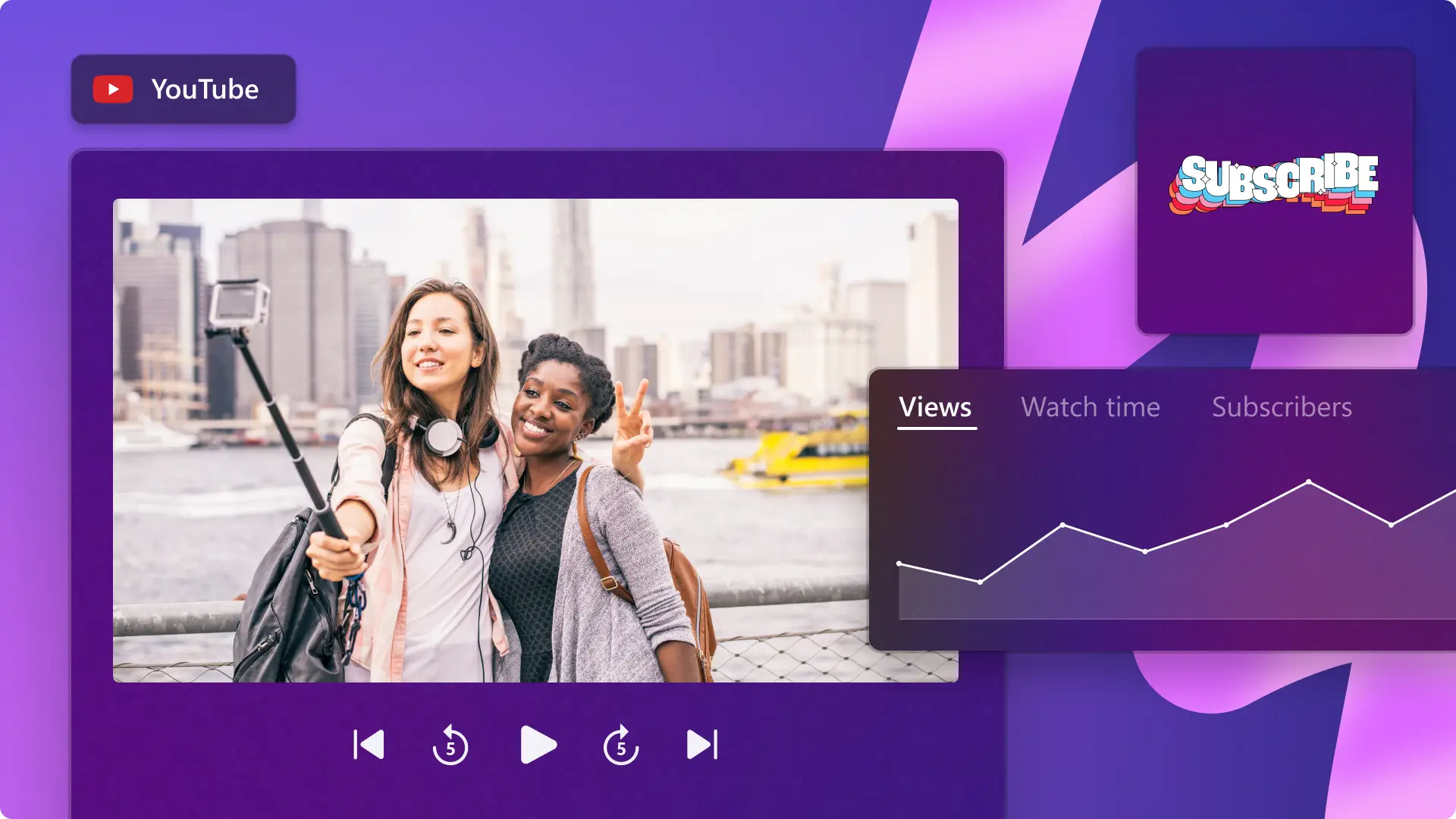Heads up! The screenshots in this article are from Clipchamp for personal accounts. The same principles apply to Clipchamp for work and school accounts.
On this page
Ever wonder why some YouTube videos instantly grab attention while others get lost in the algorithm? Well-crafted videos scripts keep viewers engaged from the very first second.
With over 69 million YouTube creators in 2025, a strong video script can be the key to success. From video titles to a closing call to action, every part of a YouTube video requires strategic planning.
Read on to explore how to write YouTube scripts that capture attention and meet YouTube requirements. Learn how to write hooks, structuring content, and creating calls-to-action that turn viewers into subscribers using the Clipchamp video editor.
How to write engaging YouTube video scripts
Set a video goal
The first step for a good YouTube script outline is to define the desired outcome for the YouTube channel and its videos.
Inform: share facts and relay information.
Educate: provide instruction or perform analysis.
Entertain: offer amusement and joy.
Hybrid: a mix of two or all the above.
Choose a niche
Select a specific topic and area of interest that the channel will focus on. A strong niche is often a sub-genre or specialist area within an existing topic or genre. The more unique the topic is, the more defined the audience will be.
Identify the target audience for scripts
Identify who is interested in the niche and gather their demographic information. The age and location of viewers will influence how video content is structured and how scripts are written. This will include language choice and tone, as well as a call to action (CTA).
Select a YouTube video format
Shorts: between 15 seconds and three minutes.
YouTube feed video: five minutes and above.
Use a unique video editing style
The duration and format of the YouTube video will influence editing style. Plan the script accordingly based on the video's estimated runtime.
Short-form: targeting short attention spans means packing in more scene changes with fast video editing, like rapid transitions. Research indicates that engagement with short-form video is two point five times higher than with long-form video.
Long-form: longer videos can mean having the rhythm to pace visuals and dialogue slowly, requiring fewer scene changes and transitions.
Appear on camera or record a voiceover
Will a video feature on-air talent, voiceover, or AI voiceover? This depends on the main goal and style of the video. If you or a performer will address the camera, the script style will need to be conversational. Voiceover scripts like those used in faceless AI YouTube channels can be more structured as they are closely tied to the supporting visuals.
Writing a YouTube Shorts script
YouTube Shorts are designed to be bite-sized snippets that inform, educate, or entertain in a small amount of time. With YouTube Shorts achieving an average engagement rate of 5.91% in 2025, crafting compelling Shorts scripts is essential. Here’s how to create great scripts for Shorts in three easy steps.
Step 1. Write a hook
A hook is an opening that immediately attracts the viewer's attention. Strong hooks grip the audience in a few seconds and keep them interested throughout the entire video.
Address a pain point: begin videos with a solution to a common problem. Leading with the problem solved will draw your viewer in and make them want to see how it’s solved.
Five hidden secrets about [X]: create a sense of insider knowledge. This is a strong hook for history and educational videos because it promises new learnings and creates a sense of intrigue.
Check out 10 hooks to explode your video views.
Step 2. Write the main content
You can either create fresh content specifically for YouTube Shorts or use a YouTube video trimmer to cut and resize YouTube videos to create highlights from your main channel. Your main content will depend on your video style and goal. Here are some writing tips for the main content in popular Shorts formats.
Listicle: script your visuals for each item in the list. Ideally, you’ll want a scene change for each sentence or new idea.
Deep dive trailer: trailers need to convey the story of the longer video while not giving away all the content. Include short snippets of highlights that are enough to capture attention without spoiling the longer video.
How-to: lead with visuals of the finished tutorial to draw viewers in, then create clear title cards for each step without obscuring the visuals.
Pro tip: the last line of the script should be the hook of the Short. This way, when the video loops, the viewer is instantly re-engaged, making them more likely to watch again without realizing where the loop restarts.
Step 3. Write the call to action
Many content creators use the sub-platform of YouTube Shorts to drive traffic to their main channel. In fact, some channels exclusively use their Shorts content for lead generation and don't send their Shorts to their existing subscribers.
A strong CTA is how you capture leads and create repeat viewers and subscribers to your channel. The call to action is often “link to full video” in comments or “head to the main channel for full video” or even “find related videos on my channel.” Time-sensitive CTAs like promotional codes or free gifts with a contest deadline help longer watch times and encourage viewers to watch the whole Short. In addition to your strategic CTA, you should also use like and subscribe buttons to encourage engagement and channel growth.
Writing a YouTube video script
Writing a YouTube feed video script requires a different approach for shortform and longform videos on the primary YouTube platform. The widescreen format and flexible time construct means you have more room to plan. Here’s how to approach writing different elements of a long YouTube video.
Step 1. Captivate with a hook
There's more time to hook readers in with long-form videos. But viewer attention still needs to be captured in the first few seconds of the video. The subtle difference with a long-form hook is starting with a small taster and slowly building intrigue to completely engage viewers. Some hook writing styles for long YouTube videos are:
Cold open: this cinematic narrative technique begins the video in the middle of an action or idea that immediately involves the viewer's imagination. It creates suspense and intrigue because it plays on the human brain's natural craving for order and understanding. Media analysis channel Now You See It provides an excellent examination and history of the technique.
Facts and stats: numbers and data convey information with a sense of palpable objectivity. Begin a video with a lesser-known fact that validates the purpose of your video may offer the viewer the promise that you have the answer they’re seeking. It also lends you credibility and expertise. Health YouTuber Bryan Johnson often opens his videos with creative uses of facts and statistics.
Surprise and twist: many YouTubers will bait and switch their viewers by promising one piece of content, then disrupting it with a new form of content. Fitness YouTuber ATHLEAN-X often performs humorous click-bait and switches with his video openings, making him look like he agrees with a common trend when his perspective is actually more nuanced.
Step 2. Establish branding
YouTube is a vast ocean of content so it’s good practice to introduce yourself and your YouTube channel and establish your brand identity in every video. This helps you connect with new viewers and remind subscribers what you’re all about. Complementing your channel intro script with a logo animation or like and subscribe buttons can also remind them to subscribe for future content.
Channel branding is how you carve out your authority in your niche. You can generate more likes and subscribes by establishing your channel’s credibility as a constant source of content. Create engaging and bite-sized intros using these Clipchamp intro templates.
Step 3. Tease the video topic
After credibility and brand identity have been established, the content of the current video should be previewed. This can be as simple as stating "In today's video…" then providing a one-sentence summary. A bit more information can also be teased out with some dot points.
Keep it concise and engaging, while instilling trust in viewers that the video will deliver the content they're seeking. Use short sentences to maintain engagement and clarity. The channel intro and the topic intro can be combined into a single segment, and it doesn't need to be lengthy. Strong introductions dedicate a sentence each to the channel and then the current topic. This consistent formula can then be refined to further increasing your watch time.
Step 4. Outline your main content
Writing a YouTube script doesn't mean word-for-word dictation. A guideline will create structure while leaving room for spontaneity, so the content feels genuine and conversational. Segment the main points and information with an outline or mind map. This will keep the main content organized. Here are some script writing tips based on content format:
Storytelling: the art of storytelling on YouTube matches gripping narration with evocative visuals. When planning a narrative, identify the main character and setting then break the story up into a clear beginning, middle, and end. You can swap the order and tell the story however you choose once you have that anchoring framework. Sports channel Secret Base is an excellent YouTube script example for storytelling. They focus on individual moments that last seconds. They then unpack these highlights by providing years of background in digestible shortform and longform videos.
Slideshows: slideshow presentations suit videos where the content creator wants to focus on information and doesn’t want to overload viewers with visuals. Write your script alongside your visuals, noting the duration and whether you need video or still footage. Educational YouTuber CGP Grey is renowned for slideshow explainer videos where he mixes animation, stock footage, and imagery as the backdrop for his masterful narration.
Listicles: listicles are a popular format all over the internet for good reason. They chunk up ideas and themes into separate bite-sized ideas. To write a listicle script, begin with a numerical list then add your key pieces of info to touch on. Lifestyle YouTuber Thomas Frank approaches the listicle with a master shot of him addressing the camera then provides the visuals by performing small sketches as examples.
Documentaries: documentary script writing should often happen alongside your research phase. Master the habit of notetaking while learning so the most fascinating parts make their way into your video. Historical channel Defunctland is all about documentaries on extinct theme parks. The script is the basis of the video, and the visuals complement the historical context of the topics covered.
Tutorial videos: how to and instructional video script writing is similar to listicles. They’re all about sequential information. When scripting, the steps will inform the video structure. Productivity YouTuber Ali Abdaal is a master of tutorials where the visuals are dynamic. He incorporates skits, infographics, and animations while speaking to the camera.
Step 5. Summarize and add call to actions
Conclude videos with a few succinct sentences that summarize the key takeaways. Once the video has been summarized, direct viewers to take the next step. YouTubers often link to another video on a similar topic or direct viewers to other social media accounts or newsletters to join for additional tips.
Utilize CTAs to cultivate a community and a loyal fan base. Not only should liking the video and subscribing be encouraged, but the viewing experience should be tailored to be more personal. Make viewers feel like they just joined a club. This can be as brief and concise as the introduction. Clipchamp video editor has a range of YouTube end screen templates that pair well with outro scripts.
Explore more YouTube outro templates.
Key scripting trends for 2025
The YouTube landscape continues evolving rapidly. Here are the most important trends shaping video scripts in 2025.
AI integration in script creation
The adoption of AI tools has more than doubled, from 18% to 41% in 2025, with creators increasingly using AI for script generation, editing, and optimization. Over 33% of YouTube Shorts creators are now utilizing text to video generator tools to convert written content into short, animated promotional videos.
Looping content strategy
YouTube is increasingly blending short-form and long-form content, creating a funnel from Shorts to more in-depth videos. Scripts should be designed to work seamlessly across formats, with Shorts acting as teasers for longer content.
Enhanced personalization
Enhanced AI personalization means scripts should be more targeted and specific to niche audiences rather than trying to appeal to everyone.
Generate AI YouTube scripts with Copilot
Not a natural with the whole coming up with words thing? Fast track your writing by using Copilot for AI script generation. Prompt Copilot to generate an outline or a complete draft of a YouTube script. You can also instruct AI tools to write a script in the same tone of voice as famous YouTubers like Liam Thompson, MKBHD, or Kevin Stratvert.
Explore more ways to use AI in five AI prompts to script videos faster. Start creating Shorts and YouTube videos with Clipchamp video editor or download the Clipchamp Windows app.
Frequently asked questions
How long should a YouTube script be?
Script length depends on video format and content type. For Shorts, aim for 100-200 words maximum. For standard videos, plan roughly 150-200 words per minute of final video content.
Should I write every word of my script?
Not necessarily. Many successful creators utilize bullet point outlines that facilitate natural conversation and highlight key points. Word-for-word scripts are more effective for educational or documentary content.
How do I make my script sound natural on camera?
Write in a conversational tone using contractions and everyday language. Read the script out loud during writing to identify awkward phrases. Practice the script several times before recording to become familiar with it. Creating a great YouTube video starts with writing scripts that feel authentic and engaging.
What's the difference between scripting for Shorts vs. regular videos?
Shorts require immediate hooks, faster pacing, and shorter attention spans. Every word counts in Shorts, while long-form videos allow for more development and explanation of ideas.
Can I create a good YouTube script template for consistent formatting?
Creating a YouTube script template can streamline the writing process and ensure consistency across videos. A good template includes sections for hooks, main content, and calls to action, making it easier to produce video clips and content efficiently.
